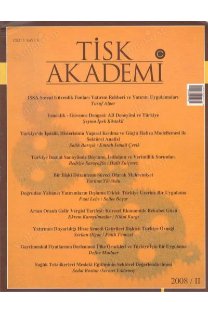Şokların yabancı ziyaretçi sayısı ve yabancı ziyaretçi harcamaları üzerindeki etkisi kalıcı mıdır?
Bu çalışmada şokların turizm ekonomisi ile ilişkili üç zaman serisi üzerindeki etkisinin kalıcı mı yoksa geçici mi olduğu araştırılmaktadır. Sağlık endişeleri (örneğin domuz gribi salgını), doğal aŞetler (örneğin deprem), politik istikrarsızlık (örneğin askeri darbe ve terör saldırıları) veya iktisadi krizler gibi pek çok olası şok turizm ekonomisini etkileyebilir. Eğer bir zaman serisi durağansa, şokun bu seri üzerindeki etkisinin muhakkak kısa süreli olacağı ve şokun ardından serinin denge değerine veya istikrarlı büyüme sürecine geri döneceği bilinmektedir. Bu çalışmada 1963-2008 dönemi Türkiye ekonomisi için yabancı ziyaretçi sayısı, yabancı ziyaretçi harcamaları ve kişi başına yabancı ziyaretçi harcamalarının durağanlık özellikleri incelenmektedir. Yapısal kırılmanın dikkate alınmadığı durağanlık testleri, yani Ng ve Perron (2001) taraŞından geliştirilen M testleri, serilerin durağan olmadığını göstermektedir. Buna karşılık bir ve iki yapısal kırılmaya izin veren durağanlık testleri kullanıldığında, sırasıyla Zivot ve Andrews (1992) ve Lee ve Strazicich (2003) testleri, test sonuçları tamamen değişmektedir. Bu durumda, test sonuçları serilerin yapısal kırılma(lar) ile durağan olduğunu göstermektedir. Bu sonuçlar Türk turizm sektörünün uzun dönemde sürdürülebilir olduğu görüşünü desteklemektedir.
Anahtar Kelimeler:
ziyaretçiler
Do shocks have permanent effect on the number of foreign visitors and foreign visitor expenditures?
This study investigates whether shocks have permanent or transitory effects on three time series related to tourism economics. There are many possible shocks, such as health scares (e.g. swine flu epidemic), natural disasters (e.g. earthquake), political instability (e.g. military coup and terrorist attacks) or economic crises that might affect tourism economics. It is well known that if a time series is stationary, then effects of shock on this series will necessarily be short-lived and after the shock series will eventually return its equilibrium value or stable growth path. In this study, stationary properties of the number of foreign visitors, foreign visitor expenditures and per capita foreign visitor expenditures are examined for Turkish case during 1963-2008 period. Unit root tests without structural break, namely M Tests developed by Ng and Perron (2001), show that series are nonstationary. However, when unit root tests that allow one and two structural breaks are employed, namely Zivot and Andrews (1992) and Lee and Strazicich (2003) tests respectively, the test results are completely changed. In this case test results show that series are stationary with structural break(s). These results support the idea that Turkish tourism sector is sustainable in the long run.
Keywords:
visitors,
___
- Bhattacharya, M. ve Narayan, P.K. (2005). Testing for the Random Walk Hypothesis in the Case of Visitor Arrivals: Evidence from Indian Tourism. Applied Economics. 37, 1485-1490
- Dickey, D.A. ve Fuller, W.A. (1979). Distribution of the Estimators for Autoregressive Time Series with a Unit Root. Journal of the American Statistical Association. 74, 427-431
- Elliott, G., Rothenberg, T.J. ve Stock, J.H. (1996). Efficient Tests for an Autoregressive Unit Root. Econometrica. 64, 813-836
- Franses, P.H. (1990). Testing for Seasonal Unit Roots in Monthly Data. Econometric Institute Report. No. 9032A. Erasmus University, Rotterdam
- Hou, J.H., Huang, P. ve Huang, D. (2006). A Unit Root Test for Two Time Series in China’s Tourism Industry. The Chinese Economy. 39, 39-48
- Kwiatkowski, D., Phillips, P.C.B., Schmidt, P. ve Shin, Y. (1992). Testing the Null Hypothesis of Stationarity against the Alternative of a Unit Root. Journal of Econometrics. 54, 159-178
- Lean, H.H. ve Smyth, R. (2009). Asian Şinancial Crisis, Avian Flu and Terrorist Threats: Are Shocks to Malaysian Tourist Arrivals Permanent or Transitory. Asia Pasific Journal of Tourism Research. 14, 301-321
- Lee, C.G. (2009). Are Tourist Arrivals Stationary? Evidence from Singapore. International Journal of Tourism Research. 11, 1-6
- Lee, J. ve Strazicich, M.C. (2001). Break Point Estimation and Spurious Rejections with Endogenous Unit Root Tests. Oxford Bulletin of Economics and Statistics. 63, 535–558
- Lee, J. ve Strazicich, M.C. (2003). Minimum Lagrange Multiplier Unit Root Test with Two Structural Breaks. Review of Economics and Statistics. 85, 1082–89
- Lumsdaine, R.L. ve Papell, D.H. (1997). Multiple Trend Breaks and the Unit Root Hypothesis. The Review of Economics and Statistics. 79, 212-218
- Narayan, P.K. (2005). The Structure of Tourist Expenditure in Fiji: Evidence from Unit Root Structural Break Tests. Applied Economics. 37, 1157–1161
- Narayan, P.K. (2008). Examining the Behaviour of Visitor Arrivals to Australia from 28 Different Countries. Transportation Research Part A. 42, 751-761
- Ng, S. ve Perron, P. (2001). Lag Length Selection and the Construction of Unit Root Tests with Good Size and Power. Econometrica. 69, 1519-1554
- Perron, P. (1989). The Great Crash, the Oil Price Shock, and the Unit Root Hypothesis. Econometrica. 57, 1361-1401
- Phillips, P.C.B. ve Perron, P. (1988). Testing for a Unit Root in Time Series Regression. Biometrica. 75, 335-346
- Said, S.E. ve Dickey, D.A. (1984). Testing for Unit Roots in Autoregressive-Moving Average Models of Unknown Order. Biometrika. 71, 599-607
- Smyth, R., Nielsen, I. ve Mishra, V. (2009). ‘I’ve Been to Bali too’ (and I Will Be Going Back): Are Terrorist Shocks to Bali’s Tourist Arrivals Permanent or Transitory? Applied Economics. 41, 1367-1378
- T.C. Kültür ve Turizm Bakanlığı. (2007). Türkiye Turizm Stratejisi 2023, Eylem Planı 2007-2013. Ankara
- TYD. (2009). Türkiye Turizmi ile İlgili Seçilmiş Veriler 2008. TYD Yayınları. 25 Mayıs 2010 tarihinde http://www.ttyd.org. tr/tr/page.aspx?id=1462 adresinden erişildi.
- Zivot, E. ve Andrews, W.K. (1992). Further Evidence on the Great Crash, the Oil Price Shock, and the Unit Root Hypothesis. Journal of Business and Economic Statistics. 10, 251-270
- ISSN: 1306-6757
- Yayın Aralığı: Yılda 2 Sayı
- Başlangıç: 2006
- Yayıncı: Türkiye Isveren Sendikalari Konfederasyonu
Sayıdaki Diğer Makaleler
SSK hastanelerinin Sağlık Bakanlığı'na devrinin hastane verimlilikleri üzerindeki etkileri
Şokların yabancı ziyaretçi sayısı ve yabancı ziyaretçi harcamaları üzerindeki etkisi kalıcı mıdır?
İşletmecilikte yeni bir metafor: Kurum DNA'sı
OLCA SÜRGEVİL DALKILIÇ, Gönül BUDAK
Türkiye'de eğitim ve sağlık hizmetlerinin geleneksellik endekslerinin hesaplanması
Selahattin BEKMEZ, Seran EVKURAN
HATİCE EROL, ABDULLAH ÖZDEMİR, ELİF MERYEM YURDAKUL
Türkiye'de fiyat istikrarının gözlenemeyen bileşenler modeli ile incelenmesi:1997:01-2009:12
Beveridge egrisi: Teori ve Türkiye uygulaması
İşverenin toplu işten çıkarma sürecini çalışanlarla görüşme yükümlülüğü
